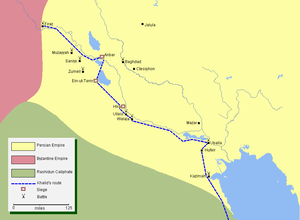Battle of Firaz
| Battle of Firaz | |||||||
|---|---|---|---|---|---|---|---|
| Part of the Arab–Byzantine Wars and Islamic conquest of Persia | |||||||
 | |||||||
| |||||||
| Belligerents | |||||||
|
Rashidun Caliphate (Rashidun army) |
Byzantine Empire Sassanid Persian Empire Christian Arabs | ||||||
| Commanders and leaders | |||||||
| Khalid ibn al-Walid | Hormozd Jadhuyih[2] | ||||||
The Battle of Firaz was the last battle of the Muslim Arab commander Khalid ibn al-Walid in Mesopotamia (Iraq) against the combined forces of the Byzantine Empire, Sassanid Empire, and Christian Arabs.[2][3]
The result of the battle was a victory for Khalid and the first Muslim conquest of Mesopotamia. The Muslim conquest of the Persian Empire was complete after their next victory at the Battle of al-Qādisiyyah.
Background
By the end of 633, the Muslims were the masters of the Euphrates valley. In this valley, Firaz at the outermost edge of the Persian Empire still had a Persian garrison. Khalid decided to drive away the Persians from this outpost as well fearing that the Persians would execute a well planned re-invasion of lost territory. He marched to Firaz with a Muslim force and arrived there in the first week of December 633. Firaz was the frontier between the empires of Persia and Byzantium, and the garrisons of the Persians as well as the Byzantines were cantoned there. In the face of the Muslims, the Byzantine garrison decided to come to the aid of the Persian garrison.
The battle
Khalid gave the enemy the option to cross the Euphrates. As soon as the enemy had crossed the Euphrates, Khalid commanded the Muslim force to go into action. The united forces of the Persians and the Byzantines had the river at their back. At Firaz, Khalid adopted the same tactics as he had adopted at Mazar. As the front ranks of both the forces committed themselves in the fighting, Khalid fixed his enemy on either flank with the help of his rear wings. Making a swift lightning movement, the Muslims dashed for the bridge on the river, and succeeded in occupying it. The enemy was thus held in a pincer movement.
Khalid's oath
In the beginning of the battle of Firaz when the odds appeared to be against the Muslims, Khalid undertook an oath that if he was victorious, he would undertake pilgrimage (Hajj) to Mecca, the House of God. After the victory of Firaz, Khalid stayed at Firaz for some days and made the necessary arrangements for the administration of the territory. In January 634, while a garrison was kept at Firaz, orders were issued to the main Muslim army to return to Al-Hirah. Khalid stayed behind with the rear of the army. As the army moved forward on the road to Al Hirah, Khalid separated himself from the army, and took an unfrequented route to Mecca with a small escort. Khalid reached Mecca in time to perform the Hajj. After performing the pilgrimage secretly and fulfilling his vow, Khalid and his party rode back to Al Hirah. Before the last contingent of the main army from Firaz had entered Hirah, Khalid was also there, as if he had been all the time with the rear guard.
References
- ↑ Michael G. Morony, Iraq After the Muslim Conquest, (Gorgias Press, 2005), 225.
- 1 2 Parvaneh Pourshariati, Decline and Fall of the Sasanian Empire:The Sasanian-Parthian Confederacy and the Arab Conquest of Iran, (I.B.Tauris, 2008), 201-202.
- ↑ John W. Jandora (1985), The Battle of the Yarmūk: A Reconstruction, Journal of Asian History, 19 (1): 8–21.
Primary sources
- Tabari, Abu Jaafar, Mohammed bin Jarir, Tarikh ar Rusul wal Mulk, Volume II